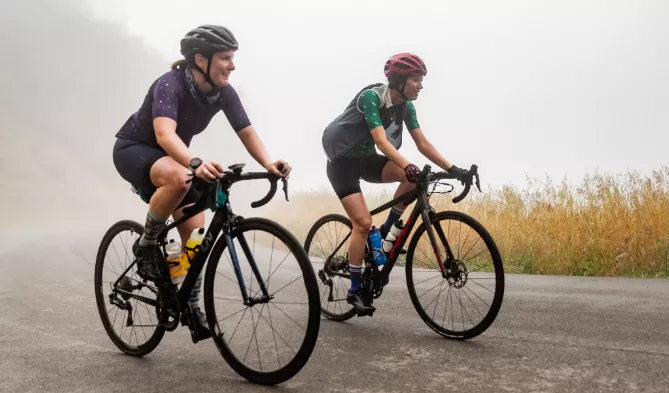Cycling is one of the best ways to enjoy the outdoors, stay healthy, and have fun. Whether you ride for fitness, transport, or adventure, cycling offers something for everyone.
What Is Cycling?
Cycling means riding a bicycle. People use bicycles for many reasons, such as traveling, exercising, racing, or exploring nature. It can be done alone or with a group.
Why Do People Cycle?
People choose cycling for many reasons. Some want to stay fit. Others want to save money on fuel or reduce pollution. Some just love to ride and enjoy the fresh air.
Types of Cycling
1. Road Cycling
This type involves riding on paved roads. It is fast and great for covering long distances. Road bikes are lightweight and have thin tires for speed.
2. Mountain Biking
Mountain biking takes place on rough and rocky trails. These bikes have thick tires and strong frames. It is perfect for those who enjoy challenges and nature.
3. Commuter Cycling
This is everyday riding to work, school, or the store. It is eco-friendly and helps save money. City bikes are designed for comfort and safety in traffic.
4. Touring
Touring is long-distance cycling, often over many days. It allows you to travel and explore. Touring bikes can carry gear and are built for comfort over long rides.
5. BMX and Stunt Riding
BMX involves tricks and racing on small bikes. It’s great for kids and thrill-seekers. It needs practice and often takes place in skateparks or dirt tracks.
6. Indoor Cycling
This type uses a stationary bike indoors. It’s popular in gyms and helps people stay fit without going outside. It’s also used for rehab and training during bad weather.
Health Benefits of Cycling
1. Improves Heart Health
Cycling gets your heart pumping. It helps reduce the risk of heart disease. It also lowers blood pressure and improves circulation.
2. Builds Muscle and Strength
Cycling works the legs, thighs, and hips. It also builds core strength. With regular riding, your muscles become stronger and more toned.
3. Boosts Mental Health
Being outdoors and active helps reduce stress. Cycling releases endorphins, which improve your mood. It can help fight anxiety and depression.
4. Helps With Weight Loss
Cycling burns calories. A long ride can burn hundreds of calories. It also boosts metabolism, helping you lose weight naturally.
5. Improves Balance and Coordination
Riding a bike improves body control. It helps with balance, especially for older adults. Better coordination can prevent falls and injuries.
Essential Cycling Gear
1. Bicycle
Choose the right bike for your needs. Road, mountain, hybrid, or city bikes all serve different purposes. Make sure your bike fits your height and body shape.
2. Helmet
A helmet protects your head. Always wear it, even on short rides. Safety comes first.
3. Clothing
Wear comfortable clothes. Padded shorts help with long rides. Bright colors and reflective gear make you more visible.
4. Lights and Reflectors
Use front and rear lights when riding in low light. Reflectors on the bike and clothing increase your safety.
5. Water Bottle
Stay hydrated. A water bottle and cage on your bike help you drink while riding.
6. Lock
If you stop anywhere, use a strong lock to protect your bike.
7. Repair Kit
A small repair kit can help fix a flat tire. It should include tire levers, a spare tube, and a pump.
Safety Tips for Cyclists
1. Follow Traffic Rules
Always ride with traffic, not against it. Obey lights and signs. Signal when turning or stopping.
2. Be Visible
Use lights at night. Wear bright or reflective clothes. Stay out of blind spots.
3. Stay Alert
Watch for cars, pedestrians, and other riders. Avoid using headphones so you can hear clearly.
4. Check Your Bike
Inspect brakes, tires, and chains often. A well-maintained bike is a safe bike.
5. Ride Defensively
Expect the unexpected. Be ready to stop or move quickly. Make eye contact with drivers at intersections.
How to Start Cycling
1. Choose the Right Bike
Visit a local bike shop. Try different types. Ask for advice based on your goals and riding style.
2. Start Small
Begin with short rides. Build up your time and distance slowly. Enjoy the journey.
3. Ride with Others
Join a local cycling group. It’s a great way to learn and stay motivated. It also adds to the fun cycling experience.
4. Learn Basic Repairs
Know how to fix a flat tire or adjust your seat. This will make you more independent and confident.
5. Explore New Places
Use cycling to discover your city, parks, or countryside. Combine it with outdoor cycling or fun hiking for even more adventure.
Environmental Benefits of Cycling
1. Reduces Air Pollution
Bikes don’t emit gases. Replacing short car trips with bike rides helps the planet.
2. Less Noise
Cycling is quiet. It lowers noise in busy areas and makes cities more peaceful.
3. Saves Resources
Bikes don’t need fuel. They require fewer parts and materials than cars.
4. Improves Public Health
Fewer cars mean cleaner air. More cyclists lead to healthier communities.
Fun Facts About Cycling
- The first bike was invented in 1817.
- More than 1 billion bikes exist in the world today.
- In the Netherlands, there are more bikes than people.
- The longest bike ride was over 500,000 kilometers.
Conclusion
Cycling is more than just a way to get around. It is a healthy, fun, and eco-friendly activity. Whether you’re riding on a trail, commuting to work, or exploring the countryside, cycling has something for everyone. Get a bike, put on your helmet, and start riding today. You’ll enjoy the journey, meet new people, and stay fit.
Related topics:

